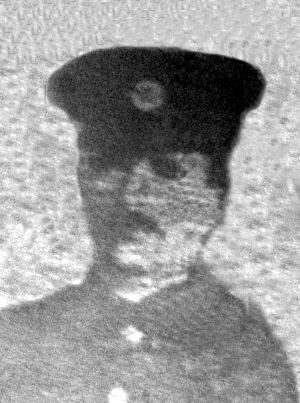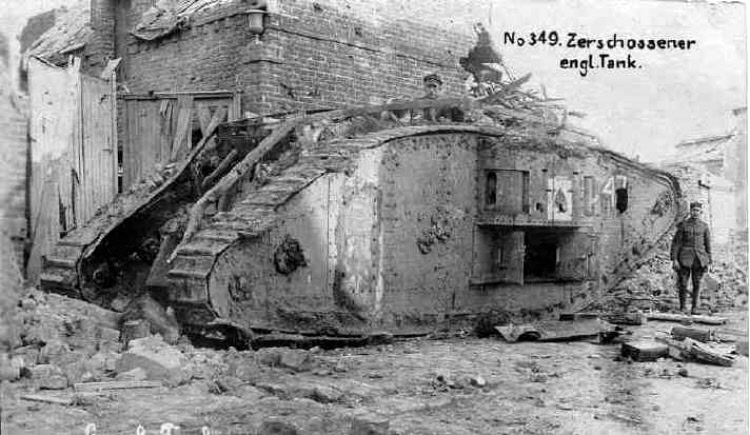
James Walsh Richmond was born in Ossett on the 7th September 1880 and baptised at South Ossett Christ Church on the 5th January 1890. He was the second child of four children born to Allan Richmond and his wife, Rachel (nee Philip), who married in early 1878. Allan was born in Lincolnshire, but Rachel and the children were all born in Ossett.
In 1891 and 1901 Allan Richmond, an overlooker in a rag warehouse, wife Rachel and their four children were living in Ossett at Field Head and latterly at Jubb’s Yard, Ossett. By 1911, Allan and Rachel Richmond had moved to Healey Road where Allan was now a rag merchant working on his own account.
On the 4th June 1906, at Ossett Holy Trinity Church, James Richmond, aged 25, married spinster Edith Annie Lockwood, aged 28, of Dewsbury Road, Ossett. In 1911, the couple were living with their one month-old daughter, Elsie Richmond, at 3, Ryecroft Street, Ossett. James was working as a rag machinist for a mungo manufacturer. At some later stage Edith Annie Richmond’s address was West Wells Road, Ossett.
James Richmond’s army service record has not survived, but it is known that he enlisted at Ossett and joined the Duke of Cambridge’s Own (Middlesex Regiment) with the service number G/86029. He died of his wounds on the 4th December 1917. James Richmond’s younger brother, Bernard Richmond, also served in the Great War and lost his life some ten weeks earlier.
Private James Richmond was posthumously awarded the British and Victory medals, but not the 1914/15 Star, indicating that he did not serve overseas before the 31st December 1915.
The 11th (Service) Battalion of the Middlesex Regiment was formed at Mill Hill, London in August 1914 as part of K1 and came under command of 36th Brigade in 12th (Eastern) Division. The battalion moved to Colchester, going on to Shorncliffe in November and in February 1915 went into Ramillies Barracks at Aldershot. In June 1915 they landed at Boulogne and on the 7th February 1918, the battalion was disbanded in France.
The battalion remained in the Arras sector until the 30th of October 1917 when they moved to Hesdin for the Cambrai offensive in which the 12th (Eastern) Division suffered heavy losses.
After initial British successes at the Battle of Cambrai, the Germans mounted a counter attack between the 30th November and the 2nd December 1917, when James Richmond was fatally wounded: 1
“The special role of 12th Division in the attack of 20th November 1917 was to capture its first objective and then form a defensive flank to the south east, keeping in touch with 55th (West Lancashire) Division which was not attacking. Advancing from Gonnelieu, the Division moved forward through Sonnet and Pam Pam Farms, Bonavis and Lateau Wood, and dug in a defensive flank to allow the cavalry to pass unrestricted, as ordered. The next three days were spent in consolidating as the centre of the battle moved to the north.
By 29th November, it had become apparent that the enemy was assembling a force in the area of Villers Guislain, south of 12th Division in area of 55th Division. Warning orders were issued, just in time, for on 30th November at 6.45 a.m., heavy shellfire began to fall and by 7.45 a.m. Divisional HQ was already out of touch with its forward units.
The failure of the 24th November attack now became apparent as the enemy had invisibly assembled a considerable attacking force in the canal valley. A hard and confused fight followed as the German infantry advanced, the Division falling back across the recently won ground. By the end of the day the line had held at La Vacquerie. Further German efforts on the 1st December were largely held off, although by now losses to some units had been as high as 50% of the strength they had before the counter attack.
On the right flank, south of the Gouzeaucourt-Bonavis road, the break into British positions was swift. The defending 55 (2/West Lancashire) Division and much of 12 (Eastern) and 20 (Light) Divisions seemed to evaporate.
Relieved on 3-4th December, the Division, excluding its artillery which stayed a while longer, moved to Albert and from there moved by train to Aire, with billets at nearby Thiennes and Berguette.”
The “Ossett Observer” 2 had this obituary for James Richmond:
“Second Of Two Ossett Brothers Killed – The painful news was received on Thursday by Mr. Allan Richmond that his elder and only surviving son, Private James Richmond, had died in hospital on the 4th inst., from gunshot wounds in the thigh received two days previously. It is only about two months since his younger brother was killed.
In a letter to his wife who lives in Ryecroft-street, the matron of the hospital where he died informs of her of his death and states that everything that was possible was done to try and save him. He had been laid to rest in Turcourt Military Cemetery.
Private Richmond, who was 36 years old joined the A.S.C. in April last year and afterwards transferred to the Middlesex Regiment. He was home on leave about six weeks ago and had only been in France about one month. He formerly worked for Mr. R. Wood and Son, Church-street.”

Above: A British tank, a casualty at the Battle of Cambrai, with the the Ace of Spades, symbol of 12th (Eastern) Division, painted on its side.
Private James Richmond, aged 37 years, husband of Edith Annie Richmond, of West Wells Road, Ossett, died on the 4th December 1917. He is buried at grave reference III. E. 28 at the Tincourt New British Cemetery, 3 Somme, France. Tincourt is a village about 7 kilometres east of Peronne and Tincourt New British Cemetery is on the west side of the village, just off the D199.
The villages of Tincourt and Boucly were occupied by British troops in March 1917, during the German Retreat to the Hindenburg Line From the following May until March 1918, Tincourt became a centre for Casualty Clearing Stations. On the 23rd March 1918, the villages were evacuated and they were recovered, in a ruined condition, about the 6th September. From that month to December 1918, Casualty Clearing Stations were again posted to Tincourt.
The cemetery was begun in June 1917, and used until September 1919; the few German burials, during their occupation of the village, are in Plot VI, Row A. After the Armistice it was used for the reburial of soldiers found on the battlefield, or buried in small French or German cemeteries.
The following were among the graveyards from which British graves were concentrated to Tincourt New British Cemetery:-
Barleux French Military Cemetery No.2, between Barleux and Belloy-en-Santerre, containing the graves of two soldiers of the 1st Loyal North Lancs who fell in February 1917.
Bernes Churchyard (near Roisel, in the Somme), which contained the graves of 18 soldiers from the United Kingdom, one Canadian, and 38 German.
Howitzer Wood Cemetery, Clery-sur-Somme, a French cemetery in the Bois des Ourages, containing the graves of three soldiers from the United Kingdom and one from Australia.
Jeancourt Indian Cemetery (close to Jeancourt Communal Cemetery), in which 15 Indian cavalrymen were buried in 1917 and to which 541 German graves were concentrated after the Armistice.
Le Mesnil Churchyard German Extension (at Le Mesnil-Bruntel), which contained the graves of ten soldiers from the United Kingdom and 150 German soldiers.
Le Verguier German Cemetery, near the Church, containing 292 German graves and those of five soldiers from the United Kingdom who fell in April 1918.
Longavesnes British Cemetery, on the West side of that village, containing the graves of 19 soldiers from the United Kingdom and three American soldiers, who fell in September and October 1918.
Magny-La-Fosse Churchyard Extension, made by an Advanced Dressing Station in October 1918, and containing the graves of seven soldiers from the United Kingdom and one from Australia and three men of the Chinese Labour Corps.
Manancourt Churchyard, which was closed to civil burials in 1865 but was used by both sides during the War. It contained the graves of ten soldiers from the United Kingdom and one from South Africa.
Marquaix German Cemetery, on the North side of that village, containing the graves of ten soldiers from the United Kingdom, one French and 338 German.
Peronne Communal Cemetery German Extension, containing the graves of 25 British and 824 German soldiers.
Ramicourt Communal Cemetery Extension, made by the Germans and taken over in October 1918, by the British. It contained the graves of ten soldiers from Australia and one from the United Kingdom.
Suzanne French Military Cemetery No.1, near the Chateau of Suzanne, containing the graves of one soldier from the United Kingdom, one from Australia, 255 French and one German.
Tincourt German Cemetery, near the German hospitals to the South-West of the village. It was used in the summer of 1918, and it contained the graves of 13 soldiers from the United Kingdom, three from Canada and one from Australia.
Vraignes Churchyard, in which three soldiers from the United Kingdom were buried by the enemy in March and April 1918.
Vraignes Communal Cemetery German Extension, in which one British and 117 German soldiers were buried.
The graves of 136 American soldiers, buried here in the autumn of 1918, and one who died in December 1917, and those of two Italian soldiers, have been removed to other cemeteries.
There are now nearly 2,000, 1914-18 war casualties commemorated in this site. Of these, over 250 are unidentified and special memorials are erected to seven soldiers from the United Kingdom and one from Australia, known or believed to be buried among them. Other special memorials record the names of 21 soldiers from the United Kingdom, two from Canada, one from Australia and one from South Africa, buried in other cemeteries, whose graves were destroyed by shell fire. There are 151 German burials here, 7 being unidentified.
The cemetery covers an area of 6,149 square metres.
References:
1. The 12th (Eastern) Division in 1914-1918
2. “Ossett Observer”, 15th December 1917